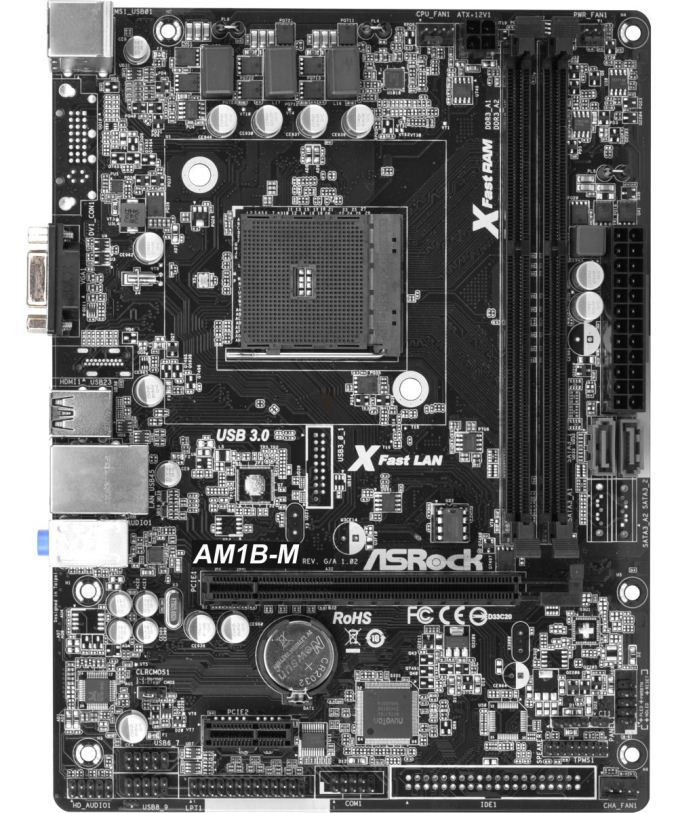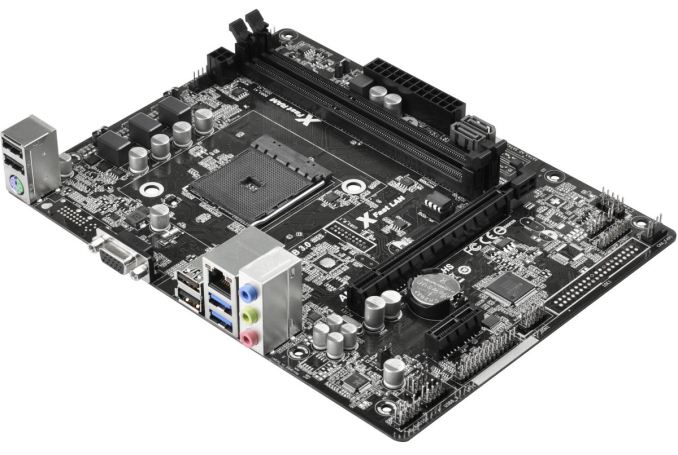The AM1 Kabini Motherboard Preview: Analyzing the Hardware
by Ian Cutress on April 19, 2014 2:00 PM ESTASRock AM1B-M
ASRock’s first motherboard falls under the $40 mark and also represents a slightly different variation on the theme. So far no two motherboards have been alike, and the ASRock AM1B-M exchanges the higher audio and video outputs instead for more rear USB 2.0 ports and an extra fan header. On the face of it, this does not seem like a good deal compared to the previous MSI, unless you need extra USB 2.0 ports.
The AM1B-M seems to have a lot of spots unoccupied by connectors. This is mostly likely due to variations of products, where the cheapest tends to have expensive connectors removed to hit a price point. We see two SATA ports missing, an IDE pin layout but no connector, and also a DVI connection missing on the rear panel. In the middle of the board is also a USB 3.0 pin layout, suggesting that another model has an additional USB 3.0 controller as well.
What the ASRock AM1B-M also does differently to all the motherboards we have examined before now is include a COM port, LPT port and a TPM port on the same PCB. It would be interesting to see which niche that combination would be good for.
The PCIe layout uses the PCIe 2.0 x4 from the chipset in a full sized slot, with an additional PCIe 2.0 x1 underneath. Thankfully the SATA ports are alternate facing for removing locking SATA cables, and the placement of the 4-pin CPU connector also helps cable routing. The AM1B-M has three fan headers, one more than the others – two on the top of the motherboard either side of the DRAM slots, and a third on the bottom right.
The AM1B-M has four USB 2.0 ports on the rear panel, or what I like to call my happy minimum (installing an OS via USB helps with at least three USB 2.0 ports). That being said, the sole VGA connector looks lonesome, and the ALC662 audio codec is not a particularly good choice.
| ASRock AM1B-M | |
| Price | Link |
| Size | Micro-ATX |
| CPU Interface | FS1b |
| Chipset | Kabini |
| Memory Slots |
Two DDR3 DRAM slots, supporting 16GB Single Channel, 1066-1600 MHz |
| Video Outputs | VGA (2048x1536 at 60 Hz) |
| Onboard LAN | Realtek RTL8111GR |
| Onboard Audio | Realtek ALC662 |
| Expansion Slots |
1 x PCIe 2.0 x16 (x4) 1 x PCIe 2.0 x1 |
| Onboard SATA/RAID | 2 x SATA 6 Gbps |
| USB 3.0 | 2 x USB 3.0 (Chipset) [rear panel] |
| Onboard |
2 x SATA 6 Gbps 2 x USB 2.0 headers 3 x Fan Headers 1 x TPM Header 1 x LPT Header 1 x COM Header Front Panel Header Front Audio Header |
| Power Connectors |
1 x 24-pin ATX 1 x 4-pin CPU |
| Fan Headers |
1 x CPU (4-pin) 1 x CHA (4-pin) 1 x SYS (3-pin) |
| IO Panel |
1 x PS/2 Combination Port VGA 2 x USB 3.0 4 x USB 2.0 1 x Gigabit Ethernet Audio Jacks (ALC662) |
| Product Page | Link |














64 Comments
View All Comments
coolhardware - Saturday, April 19, 2014 - link
Nice brief overview of the motherboards, wish there was some more meat to the article. I guess that comes later!I have the MSI AM1I with an Athlon 5350 and have been loving it. The MSI can actually do a slight CPU OC by setting the multiplier to 21x which gets the clock to 2.1GHz (as opposed to 2.05GHz stock) and it overclocked my 1333 memory to 1666 with no problem. Overall it's a sweet little board for the price!
Anybody else with other AM1 motherboards notice any OCing options?
I'm posting my experiences here: http://www.jdhodges.com/blog/amd-kabini-athlon-535...
Also, I want to find out if it can drive three displays (DVI+VGA+HDMI) and looking forward to trying some high-res output from the HDMI port. I doubt the DVI is dual link, but I plan to find out for sure by trying my trusty Dell 30" 2560x1600 display :-)
meacupla - Saturday, April 19, 2014 - link
does SODIMM DDR3L cost more to implement than desktop DDR3?All of these boards could have saved a ton of space by going with SODIMM, but none have.
Why?
MonkeyPaw - Saturday, April 19, 2014 - link
With the SOC taking on most of the work, the boards don't need to worry about space savings, as they still need to fit in the standard ITX/ATX form factors. I imagine the legacy DIMM slots are cheaper anyway. These boards are engineered for cheap, which is why you see 10/100, 2.1 audio, USB 2.0, or limited expansion options. If a better option was even 5 cents more, they probably skipped it. I'm surprised these things aren't white boxed!Voldenuit - Sunday, April 20, 2014 - link
Ian: is the Biostar mini-DTX (23x17 cm) instead of mini-ITX? I haven't heard of mini-ITX plus before.Voldenuit - Sunday, April 20, 2014 - link
Typo: Mini-DTX is 20.3x17cmElFenix - Monday, April 21, 2014 - link
the board is 19.1x17, so it fits within the mini-DTX size specification. however, biostar calls it micro atx on its website.geniekid - Tuesday, April 22, 2014 - link
It is mini-DTX, but I guess it shows how unpopular the spec is given that even an AT writer came up with his own term for it.IMO there's a lot of potential for mDTX for people who want compact systems without giving up a graphics card or their audio card.
yannigr - Sunday, April 20, 2014 - link
I hope there is an overclocking part coming in the future. I have seen a 5150 running at 2.1GHz(ASUS board). On the other hand at Phoronix they hit the wall at 105MHz bus for some reason.An article about overclocking, especially the Sempron, would have been great. There is a possibility that Sempron to be the second product from AMD that I will buy and will have a 3850 as a model number. I am just waiting for more info from around the net.
PS If kabinis where black edition chips AMD wouldn't be able to produce them fast enough.
coolhardware - Sunday, April 20, 2014 - link
MSI can run the 5150 at 2.1GHz as well, screenshots here:http://www.jdhodges.com/blog/amd-kabini-athlon-535...
Anybody seen more than 21x on a 5150? And do the lower end Kabini's overclock any?
yannigr - Monday, April 21, 2014 - link
It is NOT the 5150 in the test but the 5350. Look the link itself. It says 5350.MSI only seems to have the option to change the multiplier, not the bus speed. And the multiplier will give you extra 50MHz IF the APU has a multiplier with a .5 in it, like 5350 it has 20.5 multiplier. So you can change it to 21. If this was a 5150 with 16 multiplier you wouldn't be able to go any higher than that. Not a single MHz.
Thanks for the link anyway!